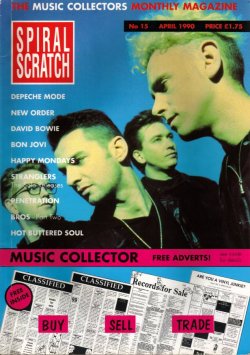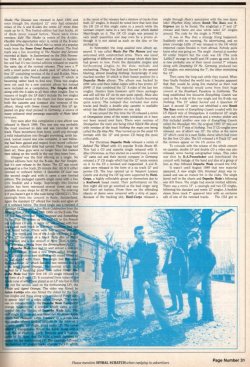Depeche Mode
[Spiral Scratch, April 1990, Words: Uncredited. Pictures: Uncredited.]






In this feature we take a look at one of the UK’s most popular “Synthesiser” bands. It was early 1981 when synthesisers were at last being appreciated (and affordable) and synthetic pop was taking the public and the clubs by storm. Whereas artists like Gary Numan had hard-hitting bass synths, Jean Michel Jarre played synths like an orchestra and where Kraftwerk were purely ‘electronic’, Depeche Mode had a synthetic pop sound that was for teenagers and for dancing to. Of course this was just the surface, as time and the odd track proved, they also had all the other styles of synth music woven into the paths of their tunes and that there was more meaning to the tracks than just teeny-pop.
They were formed in 1980 and consisted of Vince Clarke, Andy Fletcher and Martin Gore. At this point they left their guitars behind them and entered the world of synthesisers and this is when they found vocalist David Gahan. The band was complete and ready to hit the country. They were eventually signed by Daniel Miller the head of Mute records with not much more than a handshake and an honest word or two. He said “I haven’t got much money but I will do the best I can for you,” whereas all the other companies just promised “loads of money”. The band agreed Daniel was the most honest and forthright person they had met in the music industry so far and signed to his label.
Daniel Miller (aka “The Normal” and “Robert Rental”) started up Mute Records in 1978 with his own single T.V.O.D. and ever since has always expressed a preference for electronic / synthesiser music as long as it was something special. To date only two artists on his label have struck commercial gold, Depeche Mode and Erasure. The label itself has a fair few releases in its pocket – having just passed the “Mute 100” prefix – and each artist seems to have some following somewhere along the line. Usually you find that if you like one artist on Mute you’ll like a couple of others too. Mute have generally been kind to the collector in both its releases and music content. Most Mute artists extend both the A and B sides on their 12” singles and when a remix comes out they remix both the A and B sides again and give you another (usually new or remixed) track as an extra track. If this isn’t the case there’s probably a live track (or two, or three) to be found on the disc.
Depeche Mode’s first single Dreaming Of Me only saw a 7” release and this only reached number 57. It is the most collectable standard 7” release by them usually because of the B-side Ice Machine. But with reissue CDs, a CD single from West Germany and the CD album in the UK, this track is now available elsewhere in its original form.
Depeche Mode moved on releasing another single New Life which had a 12” release, as did all their following singles, and fared a lot better in the charts by reaching number 11. They had finally arrived. Their first album Speak And Spell charted in the top ten and another single Just Can’t Get Enough confirmed their status by getting to number 6. [1] During 1981 they contributed to two things. The first was a track, Photographic, used on the Some Bizzare album which is now fairly rare. The second is one side of a red Flexipop flexidisc which had the track I Sometimes Wish I Was Dead on it.
It was at the end of 1981 when the shock departure of Vince Clarke stunned the public. In fact he was to do this several more times with other artists before finally settling with Andy Bell of Erasure.
He was replaced by Alan Wilder, although at first this was only for live work, and their next album was recorded only as a trio and produced three singles: See You, The Meaning Of Love and Leave In Silence. The first two singles had non-album tracks on the B-side while the third had an excerpt from one of the album tracks. This third single was also the start of the “BONG” code. Most Mute singles have a “Mute” prefix but Depeche Mode were given their own. This treatment has only been given to Vince Clarke and Depeche Mode who of course Vince was originally a member. All three singles managed to reach the top twenty.
[Spiral Scratch, April 1990, Words: Uncredited. Pictures: Uncredited.]
" Their movement from teeny, synth pop through a mild industrialism into thought provoking, synth layered, textual sound was now complete... Their image had been set, these guys were no longer boys, but mature men taking on the world in the way they knew how. "
Run-of-the-mill and uninspired article for collectors, detailing the various formats and contents of Depeche Mode releases throughout the Eighties. The accuracy is a bit off the mark and the proofreader needed shooting, so while there are some interesting tidbits, a new reader would do well to try the much better Record Collector articles for similar information.






In this feature we take a look at one of the UK’s most popular “Synthesiser” bands. It was early 1981 when synthesisers were at last being appreciated (and affordable) and synthetic pop was taking the public and the clubs by storm. Whereas artists like Gary Numan had hard-hitting bass synths, Jean Michel Jarre played synths like an orchestra and where Kraftwerk were purely ‘electronic’, Depeche Mode had a synthetic pop sound that was for teenagers and for dancing to. Of course this was just the surface, as time and the odd track proved, they also had all the other styles of synth music woven into the paths of their tunes and that there was more meaning to the tracks than just teeny-pop.
They were formed in 1980 and consisted of Vince Clarke, Andy Fletcher and Martin Gore. At this point they left their guitars behind them and entered the world of synthesisers and this is when they found vocalist David Gahan. The band was complete and ready to hit the country. They were eventually signed by Daniel Miller the head of Mute records with not much more than a handshake and an honest word or two. He said “I haven’t got much money but I will do the best I can for you,” whereas all the other companies just promised “loads of money”. The band agreed Daniel was the most honest and forthright person they had met in the music industry so far and signed to his label.
Daniel Miller (aka “The Normal” and “Robert Rental”) started up Mute Records in 1978 with his own single T.V.O.D. and ever since has always expressed a preference for electronic / synthesiser music as long as it was something special. To date only two artists on his label have struck commercial gold, Depeche Mode and Erasure. The label itself has a fair few releases in its pocket – having just passed the “Mute 100” prefix – and each artist seems to have some following somewhere along the line. Usually you find that if you like one artist on Mute you’ll like a couple of others too. Mute have generally been kind to the collector in both its releases and music content. Most Mute artists extend both the A and B sides on their 12” singles and when a remix comes out they remix both the A and B sides again and give you another (usually new or remixed) track as an extra track. If this isn’t the case there’s probably a live track (or two, or three) to be found on the disc.
Depeche Mode’s first single Dreaming Of Me only saw a 7” release and this only reached number 57. It is the most collectable standard 7” release by them usually because of the B-side Ice Machine. But with reissue CDs, a CD single from West Germany and the CD album in the UK, this track is now available elsewhere in its original form.
Depeche Mode moved on releasing another single New Life which had a 12” release, as did all their following singles, and fared a lot better in the charts by reaching number 11. They had finally arrived. Their first album Speak And Spell charted in the top ten and another single Just Can’t Get Enough confirmed their status by getting to number 6. [1] During 1981 they contributed to two things. The first was a track, Photographic, used on the Some Bizzare album which is now fairly rare. The second is one side of a red Flexipop flexidisc which had the track I Sometimes Wish I Was Dead on it.
It was at the end of 1981 when the shock departure of Vince Clarke stunned the public. In fact he was to do this several more times with other artists before finally settling with Andy Bell of Erasure.
He was replaced by Alan Wilder, although at first this was only for live work, and their next album was recorded only as a trio and produced three singles: See You, The Meaning Of Love and Leave In Silence. The first two singles had non-album tracks on the B-side while the third had an excerpt from one of the album tracks. This third single was also the start of the “BONG” code. Most Mute singles have a “Mute” prefix but Depeche Mode were given their own. This treatment has only been given to Vince Clarke and Depeche Mode who of course Vince was originally a member. All three singles managed to reach the top twenty.
[1] - Just Can't Get Enough in fact reached number 8.
